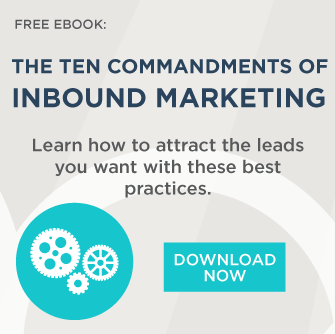3 Ways Inbound Marketing Helps Build a Brand
Your company brand is more than your logo and website. Your brand is your company’s identity. It’s how others perceive you. You can’t buy one, borrow...
3 min read
 Dean Moothart
:
June 1, 2020
Dean Moothart
:
June 1, 2020


When the COVID-19 crisis hit, many businesses wrestled with the "three P's" of a business disruption or an economic downturn—panic, paralysis, and pessimism. It’s an understandable reaction when we’re blindsided by such an unexpected event.
Managing Partner, Jim Hopes of The Center For Sales Strategy tells us that these “three P’s” are your enemy, and your best strategy in business (and in life) is to minimize each of them. This is easier said than done, but one way to move beyond the “three P’s” is to instead focus on the “three A’s”—assess, adapt, and accelerate.
 Before you proclaim, "full steam ahead" and charge back into the market, take advantage of the slowdown in business, and assess the current conditions. Ask yourself these questions:
Before you proclaim, "full steam ahead" and charge back into the market, take advantage of the slowdown in business, and assess the current conditions. Ask yourself these questions:
It may even make sense to conduct new target persona research. Instead of guessing what’s changed in your market, go directly to the market and ask them.
Then take what you’ve learned and compare it to your marketing strategy, content calendar, and campaign plans.
This assessment may reveal that some adaption is required. Many companies have discovered that they are too reliant on outbound prospecting tactics to fill their sales pipelines. Outbound prospecting has always been a numbers game (i.e., make 100 calls to get 5 appointments). But over the years, the numbers seem to be getting bigger. You must make more and more calls to get fewer and fewer appointments.
COVID-19 seems to have accelerated this trend. In many cases, it’s no longer possible to call a target company’s switchboard and get transferred to the appropriate decision-maker. The person you’re trying to engage is not in the office; they’re at home working with their cell phone at their dining room table. Unless you know their cell phone number, your prospecting efforts will completely miss them. The bad news is that this may not be a temporary phenomenon.
A recent Garter Inc. survey of CFOs indicates that “nearly a quarter of respondents said they will move at least 20% of their on-site employees to permanent remote.”
So, how do you reach these seemingly unreachable decision-makers? Inbound marketing.
Inbound marketing is a methodology used to attract the attention of prospects using content creation and drawing them to you — so that they “raise their hand,” letting you know they have a need or an interest. The key is to publish valuable content that positions you and your business as thought leaders, subject matter experts, and trusted advisors. Publishing this type of content helps your prospects find you no matter where they’re working from. And it builds trust in your prospect’s terms and timeframe. Publishing content that’s relevant to your target audience helps you transform your website from a static online brochure to a dynamic lead generation machine. This will only happen, however, if your website provides a mechanism to capture the identity of your website visitors and start engaging with them digitally. HubSpot marketing automation software will allow you to build this functionality into your existing website —without having to do a complete website redesign.
Publishing content that’s relevant to your target audience helps you transform your website from a static online brochure to a dynamic lead generation machine. This will only happen, however, if your website provides a mechanism to capture the identity of your website visitors and start engaging with them digitally. HubSpot marketing automation software will allow you to build this functionality into your existing website —without having to do a complete website redesign.
Just because you ramp up your inbound marketing tactics doesn’t mean you should completely abandon outbound. Your sales team should continue to engage their prospects via the phone and email. Your inbound tactics will make their outbound efforts much more effective. Instead of trying to “boil the ocean,” they can focus their efforts on the people who are visiting your website and consuming your published content.
Further, you can arm your salespeople with tools that will help them increase their productivity and efficiency. Sales enablement technology from companies like HubSpot can be used to automated routine sales tasks, build workflows for nurturing “not-ready-to-buy-yet” leads, and make it easier for your prospects to respond to your outreach via meeting scheduler links and online content libraries.
The economy will rebound. Will your team be ready to drive positive growth in the upcoming months? You can increase their odds by taking time now to assess your “new normal” and take steps to adapt your marketing and sales infrastructure. Then you will be ready to accelerate and grow.

Your company brand is more than your logo and website. Your brand is your company’s identity. It’s how others perceive you. You can’t buy one, borrow...
![Finding Your Shortest Route to Revenue [VIDEO]](https://leadg2.thecenterforsalesstrategy.com/hubfs/Lg2%20DEan.png)
When marketers develop their inbound marketing strategy, they’re typically focused on two primary objectives. First, they want to extend their brand....
-406484-edited.jpg)
In 2015 (yes, five years ago!), I published, “3 Things Every Media Company Needs to Do in 2015,” and it was one of LeadG2's top-performing blog...